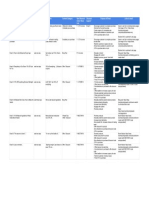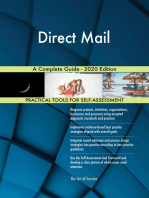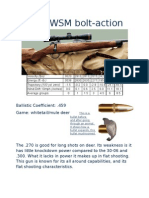SME Toolkit - Demand Forecasting
SME Toolkit - Demand Forecasting
Uploaded by
Arul RamCopyright:
Available Formats
SME Toolkit - Demand Forecasting
SME Toolkit - Demand Forecasting
Uploaded by
Arul RamCopyright
Available Formats
Share this document
Did you find this document useful?
Is this content inappropriate?
Copyright:
Available Formats
SME Toolkit - Demand Forecasting
SME Toolkit - Demand Forecasting
Uploaded by
Arul RamCopyright:
Available Formats
http://india.smetoolkit.org/india/en/content/en/416/Demand-Forecasting Home > Demand Forecasting Overall Rating: Currently 0.0/5 Stars.
Share Print Version Email
SME Toolkit Print www.smetoolkit.org
Other Translations
English English
Demand Forecasting
Provided by SME.com.ph What is a demand forecast? A demand forecast is the prediction of what will happen to your company's existing product sales. It would be best to determine the demand forecast using a multi-functional approach. The inputs from sales and marketing, finance, and production should be considered. The final demand forecast is the consensus of all participating managers. You may also want to put up a Sales and Operations Planning group composed of representatives from the different departments that will be tasked to prepare the demand forecast. Determination of the demand forecasts is done through the following steps: Determine the use of the forecast Select the items to be forecast Determine the time horizon of the forecast Select the forecasting model(s) Gather the data Make the forecast Validate and implement results The time horizon of the forecast is classified as follows:
Description
Forecast Horizon
Short-range
Medium-range
Long-range
Duration
Usually less than 3 months, maximum of 1
3 months to 3 years
More than 3 years
year
Applicability
Job scheduling, worker Sales and production assignments planning, budgeting
New product development, facilities planning
How is demand forecast determined? There are two approaches to determine demand forecast (1) the qualitative approach, (2) the quantitative approach. The comparison of these two approaches is shown below: Quantitative Approach Description Qualitative Approach
Applicability
Used when situation is vague & little data exist (e.g., new products and technologies)
Used when situation is stable & historical data exist (e.g. existing products, current technology)
Considerations
Involves intuition and experience
Involves mathematical techniques
Techniques
Jury of executive opinion Sales force composite Delphi method Consumer market survey
Time series models Causal models
Qualitative Forecasting Methods Your company may wish to try any of the qualitative forecasting methods below if you do not have historical data on your products' sales.
Qualitative Method
Description
Jury of executive opinion The opinions of a small group of high-level managers are pooled and together they estimate demand. The group uses their managerial experience, and in some cases, combines the results of statistical models.
Sales force composite
Each salesperson (for example for a territorial coverage) is asked to project their sales. Since the salesperson is the one closest to the marketplace, he has the capacity to know what the customer wants. These projections are then combined at the municipal, provincial and regional levels.
Delphi method
A panel of experts is identified where an expert could be a decision maker, an ordinary employee, or an industry expert. Each of them will be asked individually for their estimate of the demand. An iterative process is conducted until the experts have reached a consensus.
Consumer market survey The customers are asked about their purchasing plans and their projected buying behavior. A large number of respondents is needed here to be able to generalize certain results.
Quantitative Forecasting Methods
There are two forecasting models here (1) the time series model and (2) the causal model. A time series is a s et of evenly spaced numerical data and is o btained by observing responses at regular time periods. In the time series model , the forecast is based only on past values and assumes that factors that influence the past, the present and the future sales of your products will continue. On the other hand, t he causal model uses a mathematical technique known as the regression analysis that relates a dependent variable (for example, demand) to an independent variable (for example, price, advertisement, etc.) in the form of a linear equation. The time series forecasting methods are described below: Description Time Series Forecasting Method
Nave Approach
Assumes that demand in the next period is the same as demand in most recent period; demand pattern may not always be that stable For example: If July sales were 50, then Augusts sales will also be 50
Description
Time Series Forecasting Method
Moving Averages (MA)
MA is a series of arithmetic means and is used if little or no trend is present in the data; provides an overall impression of data over time A simple moving average uses average demand for a fixed sequence of periods and is good for stable demand with no pronounced behavioral patterns. Equation:
F 4 = [D 1 + D2 + D3] / 4
F forecast, D Demand, No. Period (see illustrative example simple moving average) A weighted moving average adjusts the moving average method to reflect fluctuations more closely by assigning weights to the most recent data, meaning, that the older data is usually less important. The weights are based on intuition and lie between 0 and 1 for a total of 1.0 Equation: WMA 4 = (W) (D3) + (W) (D2) + (W) (D1) WMA Weighted moving average, W Weight, D Demand, No. Period (see illustrative example weighted moving average)
Exponential Smoothing
The exponential smoothing is an averaging method that reacts more strongly to recent changes in demand by assigning a smoothing constant to the most recent data more strongly; useful if recent changes in data are the results of actual change (e.g., seasonal pattern) instead of just random fluctuations
F t + 1 = a D t + (1 - a ) F t
Where F t + 1 = the forecast for the next period D t = actual demand in the present period F t = the previously determined forecast for the present period
= a weighting factor referred to as the smoothing constant (see illustrative example exponential smoothing) Time Series Decomposition The time series decomposition adjusts the seasonality by multiplying the normal forecast by a seasonal factor (see illustrative example time series decomposition)
Copyright 2011, SME.com.ph. All Rights Reserved.
Featured Items
Leasing Equipment Sample Non-Compete Agreement Case Study Marketing of FRP moulded products Risk Manager Industry Resources
Recently Updated
Email Marketing ROI Calculator Starting Costs Estimator Pay-Per-Click Advertising ROI Calculator Discounted Cash Flow Website Conversion Rate Calculator
Back to Home
Share
Print Version
You might also like
- Dodge Ram 2005 Factory Service Repair ManualDocument20 pagesDodge Ram 2005 Factory Service Repair Manualsteven100% (62)
- Victor O. Schwab - How To Write A Good Advertisement-Wilshire Book Company (1985) - RotatedDocument123 pagesVictor O. Schwab - How To Write A Good Advertisement-Wilshire Book Company (1985) - RotatedAliciaNo ratings yet
- Science SIM (Strategic Intervention Material) For Grade 7Document20 pagesScience SIM (Strategic Intervention Material) For Grade 7Corazon Jackson89% (18)
- SolaX Power Troubleshooting X3 Hybrid PDFDocument16 pagesSolaX Power Troubleshooting X3 Hybrid PDFmarketingsunfix sunfixNo ratings yet
- Winning The Big Deal: Selling Strategic Enterprise Solutions - 27 Lessons for Sales ProfessionalsFrom EverandWinning The Big Deal: Selling Strategic Enterprise Solutions - 27 Lessons for Sales ProfessionalsNo ratings yet
- The Big IdeaDocument59 pagesThe Big IdeaJay DonatoNo ratings yet
- Course Name:Advertising Gurus SecretsDocument30 pagesCourse Name:Advertising Gurus SecretsinnerconnectionsNo ratings yet
- 6 Step Success Stories Chart e BookDocument25 pages6 Step Success Stories Chart e BookJuma BasilioNo ratings yet
- John Carlton MM Workbook PDF FreeDocument28 pagesJohn Carlton MM Workbook PDF FreeIsacNo ratings yet
- 283630Document165 pages283630Priya Priya100% (1)
- This Is A Story AboutDocument30 pagesThis Is A Story AboutAlsaba RahmanNo ratings yet
- HalbertopenersDocument10 pagesHalbertopenersXavier Miranda SalvatierraNo ratings yet
- Worksheet 1 Copywriting Brief PDFDocument1 pageWorksheet 1 Copywriting Brief PDFAaliya SayyadNo ratings yet
- UX Designer: Xinyu LiDocument1 pageUX Designer: Xinyu LiAmir KhafizovNo ratings yet
- Most Figures of Speech Cast Up A Picture in Your MindDocument7 pagesMost Figures of Speech Cast Up A Picture in Your MindDanica Abegail Ayag CorderoNo ratings yet
- Marshall McLuhan Says That TV Killed Bob KennedyDocument1 pageMarshall McLuhan Says That TV Killed Bob KennedyAlain BodinoNo ratings yet
- The Buy Impulse - Danny WallDocument69 pagesThe Buy Impulse - Danny Walla7118683No ratings yet
- Cold Calling 2.0Document16 pagesCold Calling 2.0Matthew YoungNo ratings yet
- Designed To Carve Twenty Pounds Off Your Figure in One Month! But Leave Known If For Years!Document1 pageDesigned To Carve Twenty Pounds Off Your Figure in One Month! But Leave Known If For Years!Muqaudas AbdulazeezNo ratings yet
- How To Segment Integrate Your Emails FinDocument48 pagesHow To Segment Integrate Your Emails FinMiguel BrandãoNo ratings yet
- Module 00 31Document227 pagesModule 00 31mrldc2u2No ratings yet
- Bucket Brigade WordsDocument7 pagesBucket Brigade WordsHawaii HypnosisNo ratings yet
- Create A Singular Brand FocusDocument6 pagesCreate A Singular Brand Focuswww.GrowthPanel.com100% (2)
- Could Ou Make Thegra Eat Merrill Lynch?Document1 pageCould Ou Make Thegra Eat Merrill Lynch?Brian ColborneNo ratings yet
- How To Write Letters That Win - Part1 PDFDocument12 pagesHow To Write Letters That Win - Part1 PDFzarigueiaNo ratings yet
- Email Quick Win Sequences - Ecom Health and Fitness - USD 2500 5p Comms - John PagulayanDocument4 pagesEmail Quick Win Sequences - Ecom Health and Fitness - USD 2500 5p Comms - John PagulayanHoney YuNo ratings yet
- Conversion Optimization 6 Power Tricks of The Trade Angie SchottmullerDocument78 pagesConversion Optimization 6 Power Tricks of The Trade Angie SchottmullerKavya GopakumarNo ratings yet
- 100GreatestSalesLetters Ben HartDocument225 pages100GreatestSalesLetters Ben HartPetar SimonovicNo ratings yet
- End of AmericaDocument39 pagesEnd of AmericaAnonymous MdbmF7s5No ratings yet
- 07-AI Youtube HooksDocument81 pages07-AI Youtube HooksLuiz TelesNo ratings yet
- Secret Email SystemDocument7 pagesSecret Email SystemVivek oberoNo ratings yet
- Neil RackhamDocument49 pagesNeil RackhamSumit Bhat100% (1)
- John Anghelache - Swiping ReportDocument15 pagesJohn Anghelache - Swiping Reportvagabond2010No ratings yet
- Volume 4 Power PhrasesDocument16 pagesVolume 4 Power PhrasesgusestudosNo ratings yet
- Email Sequence Abandon Cart - 9e7c226dDocument1 pageEmail Sequence Abandon Cart - 9e7c226dPaco SpitzNo ratings yet
- PsychoheadlinesDocument13 pagesPsychoheadlinesJosef JoestarNo ratings yet
- Idea VirusDocument197 pagesIdea VirusHannah WardNo ratings yet
- Saastr The Ultimate Guide To Hiring A Great VP of SalesDocument50 pagesSaastr The Ultimate Guide To Hiring A Great VP of SalesTanika JewelsNo ratings yet
- Ad Agency-Structure Functions & EvaluationDocument27 pagesAd Agency-Structure Functions & Evaluationapi-291598576No ratings yet
- 01-How To Write An Advertorial Using AIDocument3 pages01-How To Write An Advertorial Using AIJhordan WillyNo ratings yet
- Direct Marketing Is A Channel-Agnostic Form Of: AdvertisingDocument7 pagesDirect Marketing Is A Channel-Agnostic Form Of: AdvertisingFerdinand Navea100% (1)
- Headline Hacks 08 18 2012 PDFDocument55 pagesHeadline Hacks 08 18 2012 PDFbabakouniNo ratings yet
- How To Use These MindmapsDocument1 pageHow To Use These MindmapssidouNo ratings yet
- Guerrilla Marketing Articles - Why People Buy 50 ReasonsDocument2 pagesGuerrilla Marketing Articles - Why People Buy 50 Reasonstonygogo100% (1)
- 40 Business Book SummariesDocument196 pages40 Business Book SummariesAnshuman SrivastavaNo ratings yet
- Magnetic Ad Compilation (Dan Kennedy Inspiration) Swipe File ArchiveDocument1 pageMagnetic Ad Compilation (Dan Kennedy Inspiration) Swipe File ArchiveGuilherme BassoNo ratings yet
- Copywriting Cheat Sheet by Charlie PriceDocument5 pagesCopywriting Cheat Sheet by Charlie PriceAbeedNo ratings yet
- Reading Comprehension Strategy: Making Mental Images: Movies Should Take Place in Your Mind Every Time You ReadDocument16 pagesReading Comprehension Strategy: Making Mental Images: Movies Should Take Place in Your Mind Every Time You ReadMaria Isabel EtangNo ratings yet
- MOO-LAH-GY: Uncovering the Secret Cash Cow Hidden in Your BrandFrom EverandMOO-LAH-GY: Uncovering the Secret Cash Cow Hidden in Your BrandNo ratings yet
- Buying Signals: How to Spot the Green Light and Increase SalesFrom EverandBuying Signals: How to Spot the Green Light and Increase SalesNo ratings yet
- Changing the Channel (Review and Analysis of Masterson and Tribby's Book)From EverandChanging the Channel (Review and Analysis of Masterson and Tribby's Book)No ratings yet
- Voice of the Customer Analytics Complete Self-Assessment GuideFrom EverandVoice of the Customer Analytics Complete Self-Assessment GuideNo ratings yet
- Customs - Revision - Lec Nov 2018Document40 pagesCustoms - Revision - Lec Nov 2018Arul RamNo ratings yet
- Procedure For Validation of Digital Signature On PDFDocument9 pagesProcedure For Validation of Digital Signature On PDFArul RamNo ratings yet
- The 10 Stages of Corporate Life CyclesDocument2 pagesThe 10 Stages of Corporate Life CyclesArul RamNo ratings yet
- N.S. Ramnath Nilofer D'Souza Email Print Share Comment (10) : Raisina Residency by TATADocument3 pagesN.S. Ramnath Nilofer D'Souza Email Print Share Comment (10) : Raisina Residency by TATAArul RamNo ratings yet
- Ielts Speaking Quý 3 M I RaDocument13 pagesIelts Speaking Quý 3 M I RaLoan HoàngNo ratings yet
- Mech360 2022WT2 A2Document25 pagesMech360 2022WT2 A2adelNo ratings yet
- MRF Organisation Study ReportDocument84 pagesMRF Organisation Study ReportTony Jacob84% (37)
- Price List For GRE Piping MaterialDocument1 pagePrice List For GRE Piping MaterialRamadan RashadNo ratings yet
- 04 Jet Mixing Design ApplicationsDocument6 pages04 Jet Mixing Design Applicationslutfi awn100% (1)
- Pelf Infotech PVT LTD: Sbi Colony, Opp - Swapna Shilp, Kothrud, Pune - 411 038Document5 pagesPelf Infotech PVT LTD: Sbi Colony, Opp - Swapna Shilp, Kothrud, Pune - 411 038Abhijeet PatilNo ratings yet
- UMak Online Issuance of Report of Grades v1.2.2Document1 pageUMak Online Issuance of Report of Grades v1.2.2Josephine PasonNo ratings yet
- References STP Aviation EnglishDocument9 pagesReferences STP Aviation Englishexemplo55509No ratings yet
- Group 16 ProjectDocument18 pagesGroup 16 ProjectOluwa MuyiwaNo ratings yet
- Algorithm To CHKDocument14 pagesAlgorithm To CHKrajkumar.manjuNo ratings yet
- Cosmonate PH Mdi PureDocument3 pagesCosmonate PH Mdi PureOnesany TecnologiasNo ratings yet
- Examiner's Interview: F1 - Accountant in Business: Business. The Examiner, Bob Souster, Has Provided The Answers and HisDocument12 pagesExaminer's Interview: F1 - Accountant in Business: Business. The Examiner, Bob Souster, Has Provided The Answers and HisKhurram AzizNo ratings yet
- BS 6387 1994Document25 pagesBS 6387 1994Džoš FrešNo ratings yet
- Business Markets and Business Buyer BehaviorDocument14 pagesBusiness Markets and Business Buyer BehaviorKelia KellyNo ratings yet
- Friday 19 June, 2020Document2 pagesFriday 19 June, 2020Mazen FawazNo ratings yet
- Reading and Writing Text As Connected DiscourseDocument19 pagesReading and Writing Text As Connected DiscoursehadywiaijsliliNo ratings yet
- The Reward and Remuneration Series Handbook PDFDocument320 pagesThe Reward and Remuneration Series Handbook PDFOdhis KanayoNo ratings yet
- Gunnebo Lifting Standard Shackle No 854: Bow ShacklesDocument1 pageGunnebo Lifting Standard Shackle No 854: Bow ShacklesTito FebriantoNo ratings yet
- 2013 Melbourne Cup Carnival Access MapsDocument5 pages2013 Melbourne Cup Carnival Access MapsFlemington RacecourseNo ratings yet
- B Force On A Wire MC Questions PDFDocument6 pagesB Force On A Wire MC Questions PDFLynn Hollenbeck BreindelNo ratings yet
- Oracle 12.2 RAC Admin and Deploy GuideDocument459 pagesOracle 12.2 RAC Admin and Deploy Guidejordim_67No ratings yet
- Cubesat Lidar Concepts For Ranging Topology Sample Capture SurDocument7 pagesCubesat Lidar Concepts For Ranging Topology Sample Capture SurKA LANo ratings yet
- 270 WSM BoltDocument1 page270 WSM Boltslugmeister100% (2)
- Altivar 16 ManualDocument33 pagesAltivar 16 Manualpromatis5746100% (1)
- Seven Steps To Successful Strategic PlanningDocument4 pagesSeven Steps To Successful Strategic PlanningtaimostymosNo ratings yet
- Helpful Amazon LinksDocument13 pagesHelpful Amazon LinksWeslei Rodrigues NevesNo ratings yet
- ELTE2.3 DBS3900 LTE TDD Basic Feature DescriptionDocument92 pagesELTE2.3 DBS3900 LTE TDD Basic Feature DescriptioneuniceikaNo ratings yet





























































































